iPad 4 (Late 2012) Review
by Anand Lal Shimpi on December 6, 2012 4:40 PM ESTDisplay Analysis
The 4th gen iPad retains the same Retina Display as its predecessor. The 9.7-inch 2048 x 1536 display looks just as good as it did earlier this year. Brightness, black levels and contrast are all very good. The real advantage however is color accuracy thanks to Apple's factory calibration on all of its devices with an integrated display.
As with all of Apple's other Retina Displays, software support is made easy through integer scaling. The 2048 x 1536 resolution is an increase of 2x in both dimensions over the standard iPad/iPad mini resolution. App developers simply have to provide 2x scaled assets in order to make the most of the Retina Display. Deciding what image to load (standard res or 2x scaled) is handled automatically, the developer just needs to ensure that it's supplying both sets of images for the best user experience. Games can run either at the panel's native resolution, or run at a non-native offscreen resolution and simply scale up to the panel resolution if the title's performance requirements are too high (more on this later).
All first party apps and most of the 3rd party iPad apps I use on a regular basis are already Retina aware.
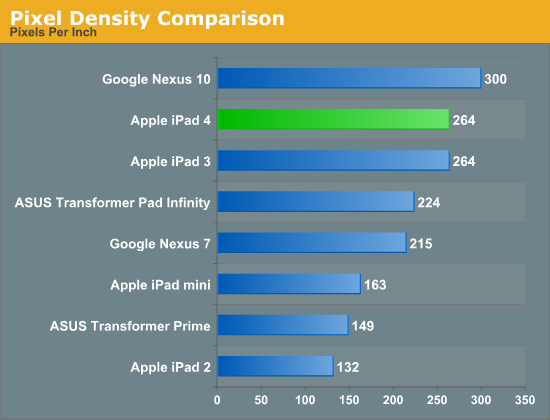
The big advantage the Retina Display offers over other iPads is a much better text reading experience. Individual letters look so much smoother:

I borrowed the paragraph shots below from our iPad mini review to give a better idea of how much of an improvement the Retina Display delivers when reading text:
Images also benefit from the Retina panel, but the advantage here ends up mostly being the accuracy of the display rather than the pixel density.

iPad mini (left) vs. iPad 4 (right)
With the exception of the 3rd generation iPad, only the Nexus 10 boasts any real competition to the iPad 4's display. I don't have a Nexus 10 on hand but Brian ran our suite of display tests on his review unit. Let's see how the two stack up in basic brightness and contrast measurements:
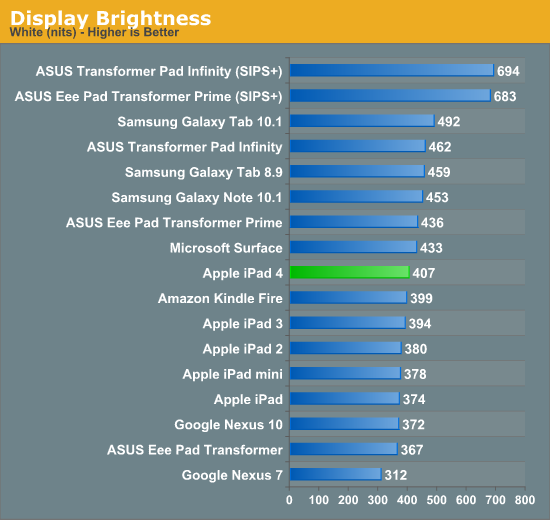
It's amazing to me that 400 nits on a nearly 10-inch display is simply middle of the pack now in modern tablets. This is just awesome. Look at any of our value notebook reviews and you'll find a bunch of displays that typically max out at sub 300 nits. It's no wonder that tablet sales are doing very well among consumers.
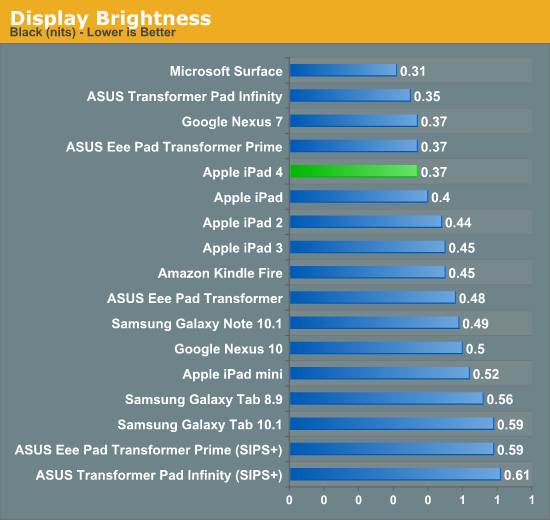
Black levels are good on the 4th generation iPad. Microsoft still holds the clear lead in black levels with its Surface RT, thanks to the tablet's bonded coverglass and display stack.
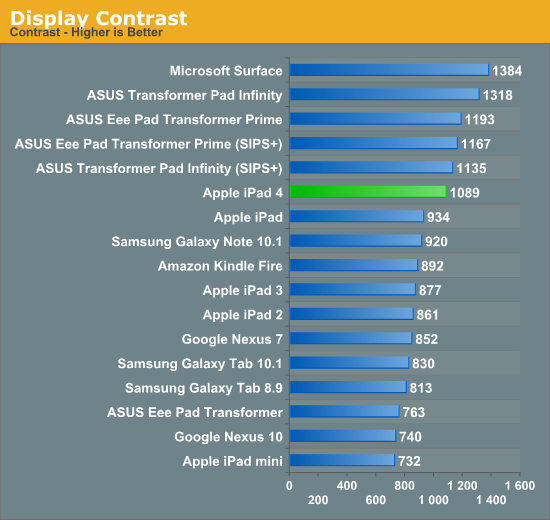
Overall contrast ratio is very good on the iPad 4. I measured a significant improvement over my iPad 3, although I suspect that has to do more with improvements to panel manufacturing than anything more deliberate.
Maintaining good brightness while pushing pixel density is only part of the equation. What made the iPad 3's display so great was that it shipped well calibrated from the factory. I assumed the same would be true for the 4th generation iPad, but I still needed to test to confirm.
To evaluate color accuracy I turned to our own Chris Heinonen's CalMAN smartphone/tablet workflow. We'll start off by looking at the calibrated white point for these tablets. What you're looking for here is a number close to 6500K:
Apple has been drifting north of 6503K for a while now. Variation in white point does seem to track well with individual panel makers in the iPad, so you may see numbers move around here depending on your luck of the draw. We've seen this in other iDevices in the past where whites will range from yellow to blue depending on what panel you end up with.
The next three charts look at accuracy represented as a difference between various source colors and what's reproduced on the display. The results are presented as average dE2000, with lower numbers being better.
First up is Grayscale performance, here we're looking at the accuracy of black, white and 19 shades of gray spread in between the two extremes:
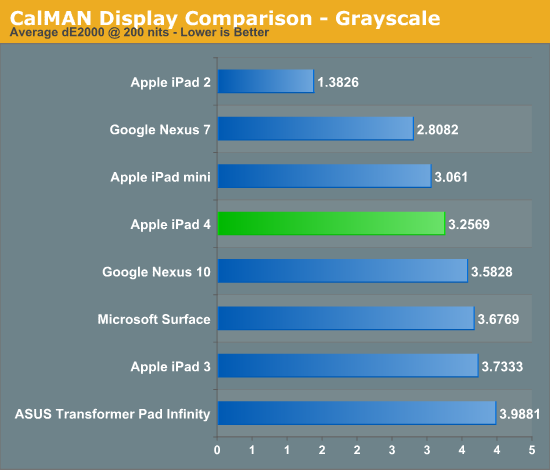
The 4th gen iPad does pretty well here, just edging out the Nexus 10 but losing to the iPad 2 and mini. Pretty much all of the tablets do a good job here at accurately reproducing grays.
First in our color accuracy tests is a saturation sweep. Here we're looking at 20%, 40%, 60%, 80% and 100% saturations of red, blue, green, magenta, yellow and cyan.
This is what you get with the iPad's pre-calibrated Retina Display: appreciably better color accuracy than any other tablet on the market today. I even measured an improvement in color accuracy compared to last year's iPad 3, however my iPad 3 was from the initial runs of production. I have noticed pretty significant variance between color accuracy between iPads. The results are always good, but some are definitely better than others.
Gamut CIE Chart
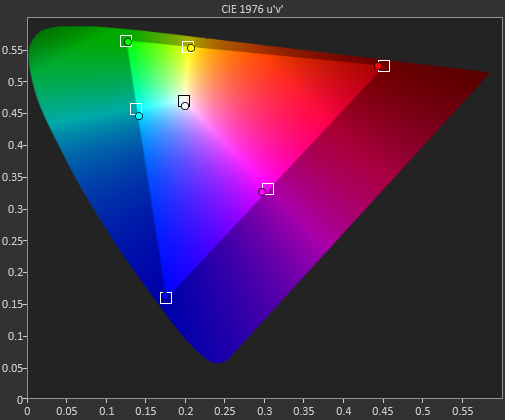
Saturation CIE Chart
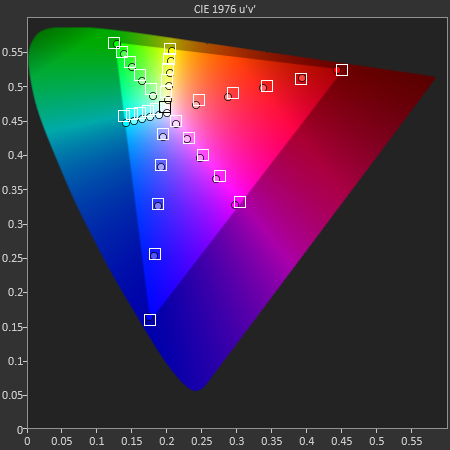
For our final accuracy test we're looking at the difference between a Gretag Macbeth colorchecker chart and the rendered swatches on these displays. Once again, lower numbers are better.
Many of the panels used here are actually good panels, the difference really boils down to calibration. Apple continues to dominate in terms of calibrated color accuracy. The 4th gen iPad's display remains the best in the industry from a color accuracy standpoint.
GMB Color Checker
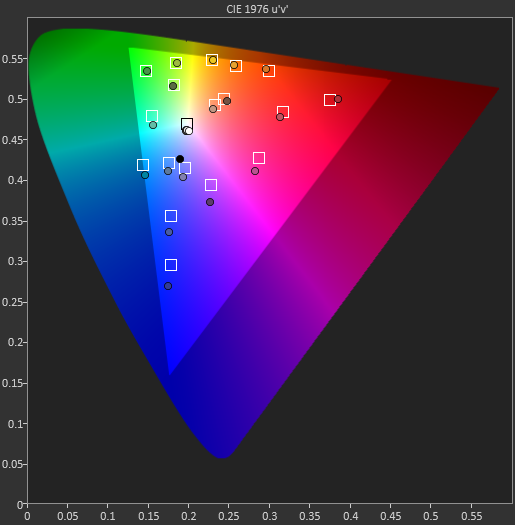




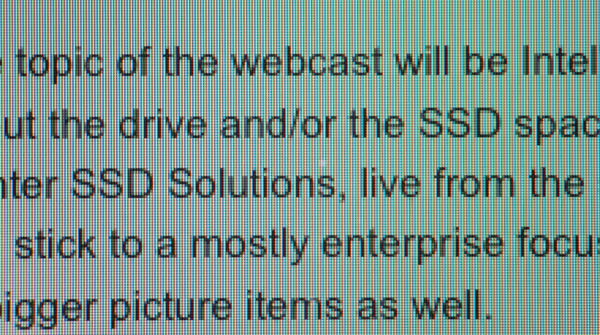
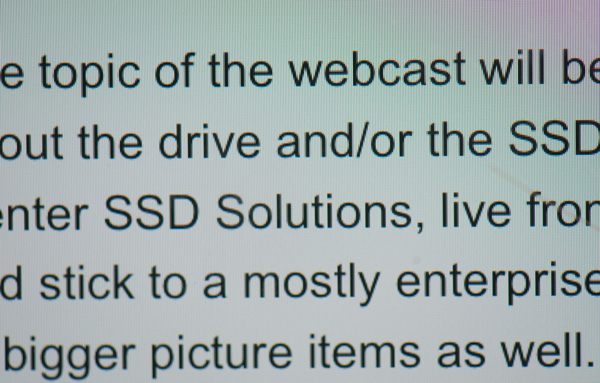
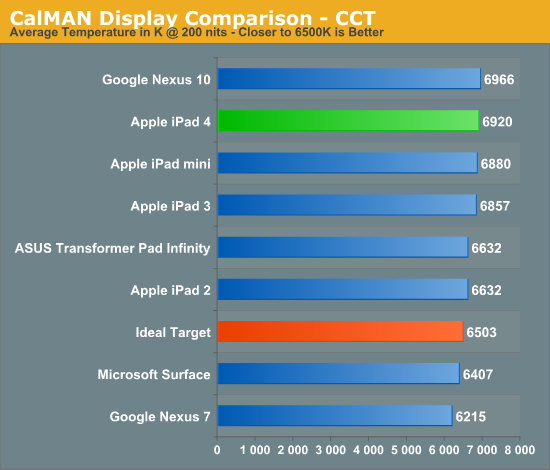
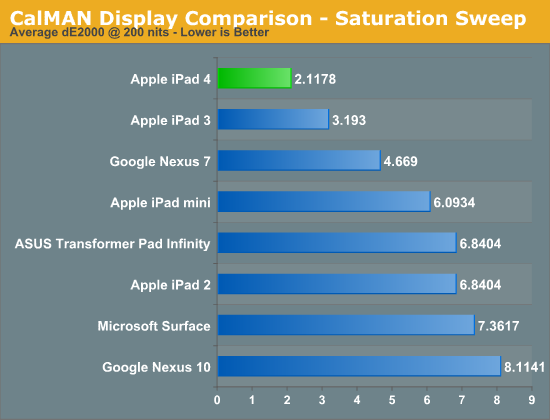
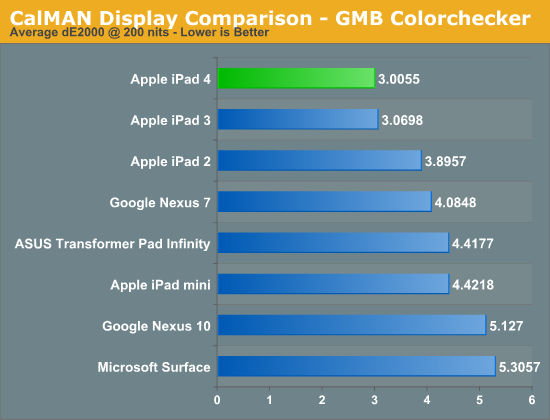








113 Comments
View All Comments
s44 - Thursday, December 6, 2012 - link
First pixel density is everything, now color calibration... Coincidentally when Apple starts promoting their selling point.zanon - Thursday, December 6, 2012 - link
None of this is new stuff kid. Pixel density has been something that a lot of us have wanted for a long time, it just somehow never was a priority for anyone. I can easily remember being awed by the IBM T220 (a 22" 3840×2400 [WQUXGA] screen) back in 2001. It used multiple dual link DVI, and the launch price was around $18k, dropping to around $8.5k a year or two later. I hoped back then that it would rapidly proliferate and descend at least to the mere "high end" level, rather then "stratospheric", but it was not to be. Similarly, color has also always mattered for a lot of us. I'm sitting in front of an NEC display built with that in mind, but there has been a whole market of higher end displays and calibration hardware since practically the dawn of color.Just because it's only now that, at long last, the industry is moving out of its previous equilibrium doesn't mean there's some conspiracy or "moving targets" or whatever other stupid BS you think of. It would have been nice to see this getting pushed harder and wider literally 10 years ago. Better late then never though. Excellent color and density should be the standard, not the exception, and I'm delighted to see everything suddenly leaping forward again. Density came first, as the most obvious, lowest hanging fruit. Color is next, first with tighter filters, hopefully next year with IGZO and quantum dot films. 120 Hz becoming standard everywhere would be nice too. Whoever helps make that happen gets a hearty thanks from me, even if I never buy any of their stuff directly.
Sabresiberian - Friday, December 7, 2012 - link
You are so right here! The introduction of the LCD set us back at least a decade, in terms of color quality, refresh rate, and pixel density.I'm not a great fan of Apple the company, but some things they do right, and do better than the PC industry. Displays in portable devices is one of those things. I'm not in the market for anyone's tablet, but I am tempted by the Retina Display notebooks.
PC portable computer manufacturers take notice: even a somewhat anti-Apple person is considering buying Apple over your junk displays. Time for you to step up your game!
Arbee - Friday, December 7, 2012 - link
I would kill for a 20" or 25" 4:3 LCD panel with something like 2048x1536 resolution on a good quality IPS panel with decent color fidelity.Heck, at this point I'd like to see any new LCD display that's 4:3 other than what's in the iPad. 4:3 is still preferable for a lot of actual work on computers (programming, word processing, spreadsheets, etc) but the industry decided unilaterally we were all just content consumers and we need a screen optimized only for movies.
tim851 - Saturday, December 8, 2012 - link
This is the "logic" of the anti 16:x crowd that I don't get.So you would kill for a 25" 4:3 panel with 2048x1536 pixels.
Why?
You are aware that a 30" 16:10 panel with 2560x1600px is
1) physically higher by almost an inch
2) has 64 more vertical pixels
Why the dislike for an extra 512 horizontal pixels?
Also, if you are willing to accept a 20" 4:3 screen: a 27" 2560x1440 screen that sells from 300$ on ebay is also physically higher (by more than 1 inch) and only has 94 viewer vertical pixels (6%)...
londiste - Saturday, December 8, 2012 - link
who said anything about dislike for horizontal pixels? it is dislike for lack of vertical pixels.anandtech site we're on fits just fine into half of my 1920 horizontal pixels, but the 120 extra vertical pixels that my 1920x1200 screen has over 1080p are extremely useful.
tim851 - Saturday, December 8, 2012 - link
The guy I responded to would "kill" for a display with 2048x1536 pixels.I wonder why, when he could have bought a display with 2560x1600 years ago.
That is MORE VERTICAL PIXELS and MORE PHYSICAL SCREEN HEIGHT.
Also, Anandtech is a very vertical site, I don't see how 120 extra pixels is helping you much there. Is scrolling 10 screens down instead of 9 really bothering you?
I use Firefox with the tree-style tab addon which puts the tabs in the sidebar, freeing up vertical space and practically using horizontal space. A lot of applications these days are optimized to use horizontal space.
Had a 21" 4:3 CRT until three years ago and let me tell you I gladly accepted a 16:9 24" LCD.
I for one prefer using two 'shallow' windows side-by-side instead of once very deep window.
Olaf van der Spek - Saturday, December 8, 2012 - link
1600p being 5x as expensive as 1080p is the real problem.Yes, more vertical pixels really matter in some cases. It's a bit like running out of memory and having to use swap, it's much slower.
Arbee - Monday, December 10, 2012 - link
I don't dislike the extra horizontal pixels, I just want more vertical pixels to go with it. I am a programmer; it is a *substantial* productivity boost to be able to see an entire function on the screen at once. Seeing more width is comparably of very limited benefit.And a $300 27" anything is unlikely to have a good-quality panel in it. I am so done with screens that go purple if you don't keep your head perfectly still (that on a $1800 Toshiba laptop) or have a weird tint to them that you can't get rid of.
xyzzy1 - Wednesday, December 12, 2012 - link
Much like Digital/CD set back musical reproduction. Digital is still trying exceed what top end analugue playback achieved! Off topic but couold not resist....